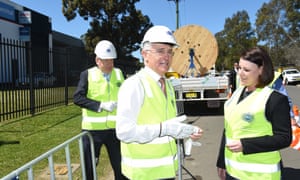Extract from The Guardian
Benchmark Akamai report ranks Australia 50 globally on average connection speed and 57th on peak connection speedThe report says the NBN is on track to roll out universal broadband access at a minimum speed of 25Mbps. Photograph: Mick Tsikas/AAP
Elle Hunt
Friday 16 December 2016 14.29 AEDT
The company that operates the national broadband network has downplayed new findings on global internet speeds that show Australia continues to lag behind other Asia-Pacific countries.
Akamai released its third-quarter “State of the Internet” connectivity report, acknowledged as a benchmark for broadband performance within the industry, on Thursday.
Australia ranked 50th in the global rankings for average connection speed, and eighth among Asia-Pacific countries and regions, with an average of 9.6Mbps for the third quarter this year – a decline of 13% on the previous quarter.
South Korea and Hong Kong were at first and second in the world, with 26.3Mbps and 20.1Mbps respectively.
Average connection speeds globally had increased by 2.3% to 6.3Mbps, a 21% increase year-over-year.
Australia’s average peak connection speed was 46.9Mbps, putting it at 57th in the world, and far behind leaders in the Asia-Pacific region such as Singapore – with the highest peak speed of the countries assessed of 162.0Mbps.
With Japan, Australia had the smallest gains year-over-year of countries within the Asia-Pacific in the third quarter, at just 12%. By comparison, Indonesia’s speeds increased by 220%. But third-quarter average mobile connections in Australia were 12.8Mbps, behind only the Philippines in the Asia-Pacific region.
The Akamai report said the NBN was on track to roll out universal broadband access in Australia at a minimum speed of 25Mbps, with 40% of the country having gigabit-speed access by 2020.
A spokeswoman for the national broadband network agreed that the findings reflected the need to bridge the digital divide in Australia, but said most of the 10m IP addresses assessed by Akamai would be “legacy ADSL services” and were not a reflection on the NBN.
The speed experienced by consumers would be ultimately dictated by their choice of package from internet service providers, she said. “Consumers may choose a 12Mbps package and that what would be what is measured, not what the line is capable of doing.”
She also noted that Australia’s average speeds had increased year-over-year.
Some 1.6m premises around Australia now have NBN services.
Internet Australia, the not-for-profit peak body representing the interests of Australian internet users, said the mix of technologies being used in the NBN meant it could not guarantee the speeds that would be delivered to all consumers.
Between 30% and 40% of premises using the NBN will be serviced by “fibre-to-the-node”, which IA’s chief executive, Laurie Patton, says will not meet Australia’s future needs, given the fact that ageing copper-wire fibres will need replacing in 10 to 15 years’ time.
“The simple fact is we are being outplayed by our global competitors who are building fibre-based systems providing speeds that cannot be matched by fibre-to-the-node,” he said.
“The wholesale speeds claimed by NBN are largely irrelevant as they are not necessarily the speeds that will be delivered to consumers. What counts is what you pay for and what you get.”
IA has been calling for the NBN to dump the fibre-to-the-node rollout in favour of the “fibre-to-the-home” approach initially committed to by Kevin Rudd’s government before being watered down by the Abbott-led government.
The annual cost to the federal budget of the government’s investment in the NBN is expected to grow in coming years.
A report by the Parliamentary Budget Office released on Wednesday estimated the cost to the budget in 2016-17 to be about $580m.

No comments:
Post a Comment